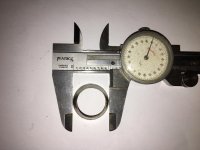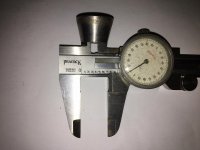View attachment 218923View attachment 218924View attachment 218925View attachment 218926View attachment 218927
Hi Everyone!
I know almost NOTHING about metal working other than rare lathe work, but I'm here to learn!!!
I found this bench top mill (at least that's what I think it is!) on CL, and purchased it today. No model number anywhere. It has a number "163" visible in the ways. Might just be a serial number...
Every Pratt and Whitney mill I've been able to find online is a "3" or "3C". I think this pre-dates them, as this doesn't have any provision for an overarm (obviously you can ignore the aluminum add-on)... And most interestingly, the rotating assembly can be positioned forward and back about 3 inches in the Y axis. The 3 and 3Cs seem to have fixed/immobile tops.
It was originally built for an overhead belt. The motor and belt configuration is a later add-on. The cabinet is an incredibly solid wooden one. Inch thick plywood, molded corner boards, even built-in wheels - you name it. So well made it looks like sheet metal.
Questions:
1) Anyone have an idea what this is?
2) It came with a single Bridgeport B3 collet and associated draw bar. There's another draw bar with it, slightly longer. I've looked, and these B3s seem to be rare... I don't know much about collets -do I have options - even if I sacrifice accuracy - if I can use other kinds?
Sorry this pictures are sideways... That gives me a headache!
I'm sure I'll have more questions. Can't wait to start exploring this! THANKS!
- Paul
Hi Everyone!
I know almost NOTHING about metal working other than rare lathe work, but I'm here to learn!!!
I found this bench top mill (at least that's what I think it is!) on CL, and purchased it today. No model number anywhere. It has a number "163" visible in the ways. Might just be a serial number...
Every Pratt and Whitney mill I've been able to find online is a "3" or "3C". I think this pre-dates them, as this doesn't have any provision for an overarm (obviously you can ignore the aluminum add-on)... And most interestingly, the rotating assembly can be positioned forward and back about 3 inches in the Y axis. The 3 and 3Cs seem to have fixed/immobile tops.
It was originally built for an overhead belt. The motor and belt configuration is a later add-on. The cabinet is an incredibly solid wooden one. Inch thick plywood, molded corner boards, even built-in wheels - you name it. So well made it looks like sheet metal.
Questions:
1) Anyone have an idea what this is?
2) It came with a single Bridgeport B3 collet and associated draw bar. There's another draw bar with it, slightly longer. I've looked, and these B3s seem to be rare... I don't know much about collets -do I have options - even if I sacrifice accuracy - if I can use other kinds?
Sorry this pictures are sideways... That gives me a headache!
I'm sure I'll have more questions. Can't wait to start exploring this! THANKS!
- Paul












